Abstract
In this paper, the integrable (2+1)-dimensional Maccari system (MS), which can model many complex phenomena in hydrodynamics, plasma physics and nonlinear optics, is investigated by the variational approach (VA). This proposed approach that based on the variational theory and Ritz-like method can construct the explicit solutions via the stationary conditions only taking two steps. Finally, the dynamic behaviors of the solutions are exhibited by choosing the appropriate parameters through the 3-D and density plots. It can be seen that the proposed method is concise and straightforward, and can be adopted to study the travelling wave theory in physics.
MSC:
35A15
1. Introduction
Many significant natural science and engineering problems arising in circuits [1,2,3] hydrodynamics [4,5,6], plasma physics [7,8,9], optics [10,11,12,13,14,15], biomedical science [16,17,18,19], vibration [20,21,22,23,24], chemistry [25,26] and so on can be attributed to the study of nonlinear partial differential equations (NPDEs). The study of NPDEs is of great value in theory and application, and can well explain various natural phenomena. In this work, we mainly study the (2+1)-dimensional MS that reads as [27,28]:
where represents the complex scalar field and indicates the real scalar field. x, y and t are the independent spatial variables and temporal variable, respectively. The (2+1)-dimensional MS can model many complex phenomenon arising in hydrodynamics, plasma physics, nonlinear optics and so on. In addition, the study of its travelling wave solution is important. Here in this work, we aim to search for the solitary and periodic wave solutions of coupled system via the VA. The rest of this article is arranged as follows: In Section 2, the variational principle (VP) is established by means of the semi-inverse method (SIM). In Section 3 and Section 4, we attain the periodic wave solution (PWS) and solitary wave solution (SWS) by applying the VA, respectively. In Section 5, the numerical results and discussion are given. Finally, we present the conclusion in Section 6.
2. The VP
To solve the coupled model, we first derive the VP in this section. To this end, the following wave transformation is introduced:
where,
where γ1, γ2, γ3, ε1, ε2 and ε3 are arbitrary constants.
Using Equations (2) and (3), we have:
Taking above results into Equation (1), Equation (1) can be transformed into the following equations:
where , , , .
Integrating Equation (5) about ξ once and setting the integration constant to zero, it gives:
Equation (4) can be separated into the real part and imaginary part, respectively, as:
Obviously, we can have the following expression in the view of Equation (8):
Substituting Equations (6) and (9) into Equation (7) yields:
By the SIM [29,30,31,32,33,34,35,36,37], the VP of Equation (10) can be found as:
To facilitate the calculation, we can re-express Equation (11) as:
where,
Comparing Equation (11) with Equation (10), it is easy to see that that the order of Equation (10) has been reduced through the VP, which makes the equation more simple. In addition, the obtained VP can imply the structural form of the solution. Next, we will find the PWS and SWS based on Equation (12) via the VA.
3. The PWSs
The target of this section is to seek the PWSs of Equation (1) by the VA [38,39,40,41]. In order to achieve this goal, we can assume Equation (10) has the following periodic solution:
Substituting the above into the Equation (12) yields:
By the Ritz-like method, there is:
which leads to:
Solving above equation, we obtain:
Substituting Equation (13) into above equation, we acquire:
So the periodic solution of Equation (10) is attained as:
In light of Equations (2) and (3), the PWS of Equation (1) can be obtained as:
With help of Equations (6) and (9), we have:
Note: We can also obtain the other different PWSs via supposing , and so on.
4. The SWSs
This section will apply the VA to derive the SWSs. For this end, we make a assumption that the solution of Equation (10) is:
where A and B are constants that to be determined later. Taking Equation (23) into Equation (12) gives:
According to Ritz-like method [42,43,44,45], the following expressions can be obtained via the stationary conditions:
From which, we have:
which results in:
Or,
In the view of Equation (13), we have:
or,
Thus, we can acquire the solution of Equation (10) as:
Or,
By the transform given in Equations (2) and (3), we have:
or
In the view of Equation (6), we have:
Thus, we can acquire the SWSs of Equation (1) as:
Family one:
Family two:
It should be noted that another SWSs can be obtained by assuming , and so on.
5. Numerical Results and Discussion
The goal of this section is to ascertain the correctness and effectiveness of the VA through one example. We choose the parameters as γ1 = −1, γ2 = 1, γ3 = 1, ε1 = 1, ε2 = 1, ε3 = 1.
For , the PWSs of Equation (1) can be obtained by using Equations (21) and (22) as:
We plot the absolute part (AP), real part (RP) and imaginary part (IP) of the PWSs given by Equation (42) through 3-D polt and density contours in Figure 1 for . Obviously, the AP, RP and IP of the solutions all have perfect periodic characteristics, that is, the profile of AP is a perfect wave, on the hand, the contours of the RP and IP are the kinky-perfect waves. They represent the periodic wave propagating along the x-axis and y-axis.
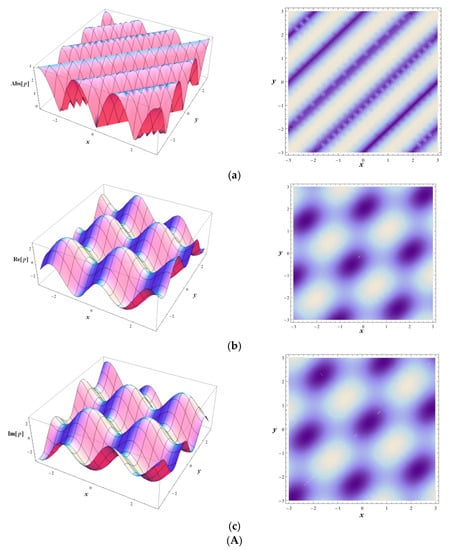
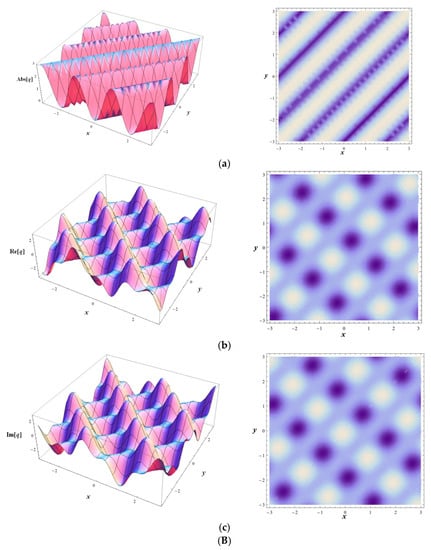
Figure 1.
The AP, RP and IP of the PWS given by Equation (42) at t = 1. (A) The performance of . (Aa) The 3-D plot and density contour of the AP. (Ab) The 3-D plot and density contour of the RP. (Ac) The 3-D plot and density contour of the IP. (B) The performance of . (Ba) The 3-D plot and density contour of the AP. (Bb) The 3-D plot and density contour of the RP. (Bc) The 3-D plot and density contour of the IP.
On basis of Equations (38)–(41), we can acquire the SWSs of Equation (1) as:
Family one:
Family two:
The AP, RP and IP of the SWSs obtained by Equations (43) and (44) are described in Figure 2 and Figure 3, respectively, at t = 2. Obviously, the AP shown in Figure 2a and Figure 3a are the bright solitary waves. In addition, the RP and IP of Equations (43) and (44) that plotted in Figure 2b,c and Figure 3b,c are the breathe-like waves, which have breathe wave characteristics.
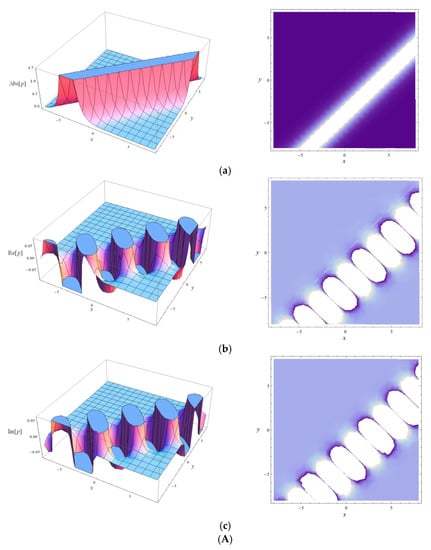
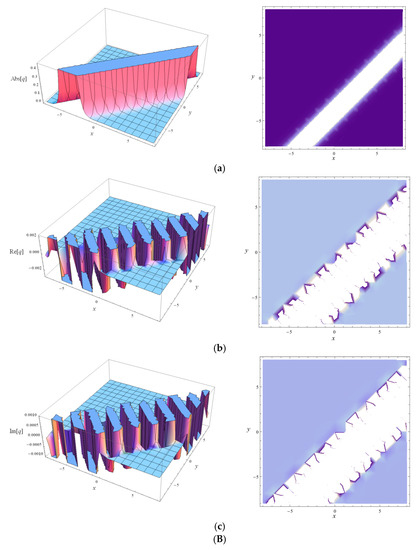
Figure 2.
The AP, RP and IP of the SWS given by Equation (43) at t = 2. (A) The performance of . (Aa) The 3-D plot and density contour of the AP. (Ab) The 3-D plot and density contour of the RP. (Ac) The 3-D plot and density contour of the IP. (B) The performance of . (Ba) The 3-D plot and density contour of the AP. (Bb) The 3-D plot and density contour of the RP. (Bc) The 3-D plot and density contour of the IP.
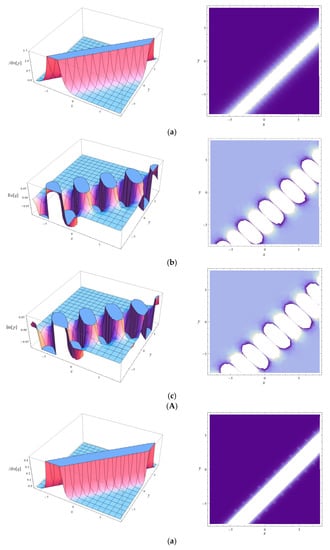
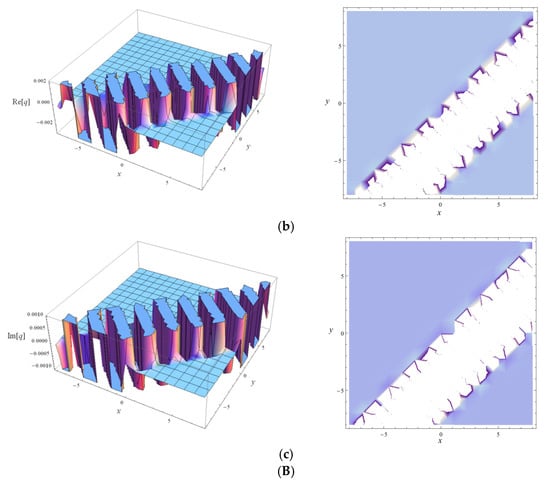
Figure 3.
The AP, RP and IP of the SWS given by Equation (44) at t = 2. (A) The performance of . (Aa) The 3-D plot and density contour of the AP. (Ab) The 3-D plot and density contour of the RP. (Ac) The 3-D plot and density contour of the IP. (B) The performance of . (Ba) The 3-D plot and density contour of the AP. (Bb) The 3-D plot and density contour of the RP. (Bc) The 3-D plot and density contour of the IP.
6. Conclusions and Future Research
In this paper, some explicit exact solutions of the integrable (2+1)-dimensional MS such as PWS and SWS are obtained by utilizing the VA. This method can simplify the equation via reducing the order of the differential equation, avoid the tedious solving process, and obtain the optimal solution through the stationary conditions. The AP, RP and IP of the solutions are illustrated by using proper parameters via the 3-D plot and density contour. The calculations demonstrate that the proposed method is simple, straightforward and effective, which is expected to bring some new inspiration to the study of the travelling wave solutions.
Recently, the fractional and fractal calculus [46,47,48,49,50,51,52,53] have attracted extensive attention in many different fields involving in physics, filter, biological, circuit and so on. How to apply the VA to the fractional and fractal calculus is worthy of consideration and in-depth study.
Author Contributions
Methodology, K.-J.W.; writing—original draft preparation, K.-J.W.; writing—review and editing, K.-J.W.; software, J.S. All authors have read and agreed to the published version of the manuscript.
Funding
This work is supported by the Key Programs of Universities in Henan Province of China (22A140006), the Fundamental Research Funds for the Universities of Henan Province (NSFRF210324) and Program of Henan Polytechnic University (B2018-40).
Institutional Review Board Statement
Not applicable.
Data Availability Statement
The data that support the findings of this study are available from the corresponding author upon reasonable request.
Acknowledgments
The authors would like to thank the editor and the anonymous reviewers for their valuable comments, which helped to improve the presentation of the paper.
Conflicts of Interest
We declare that we do not have any commercial or associative interest that represents a conflict of interest in connection with the work submitted.
References
- Ding, B.; Zhang, Z.H.; Gong, L.; Xu, M.-H.; Huang, Z.-Q. A novel thermal management scheme for 3D-IC chips with multi-cores and high power density. Appl. Therm. Eng. 2020, 168, 114832. [Google Scholar] [CrossRef]
- Sivakumar, P.; Pandiaraj, K.; JeyaPrakash, K. Optimization of thermal aware multilevel routing for 3D IC. Analog. Integr. Circuits Signal Processing 2020, 103, 131–142. [Google Scholar] [CrossRef]
- Elshaari, A.W.; Pernice, W.; Srinivasan, K.; Benson, O.; Zwiller, V. Hybrid integrated quantum photonic circuits. Nat. Photonics 2020, 14, 285–298. [Google Scholar] [CrossRef] [PubMed]
- Khater, M.M.A.; Attia, R.A.M.; Alodhaibi, S.S.; Lu, D. Novel soliton waves of two fluid nonlinear evolutions models in the view of computational scheme. Int. J. Mod. Phys. B. 2020, 34, 2050096. [Google Scholar] [CrossRef]
- Imran, N.; Javed, M.; Sohail, M.; Thounthong, P.; Abdelmalek, Z. Theoretical exploration of thermal transportation with chemical reactions for sutterby fluid model obeying peristaltic mechanism. J. Mater. Res. Technol. 2020, 9, 7449–7459. [Google Scholar]
- Sohai, M.; Nazir, l.; Bazighifan, O.; El-Nabulsi, R.A.; Selim, M.M.; Alrabaiah, H.; Thounthong, P. Significant involvement of double diffusion theories on viscoelastic fluid comprising variable thermophysical properties. Micromachines 2021, 12, 951. [Google Scholar] [CrossRef]
- Wang, K.J. Traveling wave solutions of the Gardner equation in dusty plasmas. Results Phys. 2022, 33, 105207. [Google Scholar]
- Saha Ray, S.; Sagar, B. Numerical Soliton Solutions of Fractional Modified (2+1)-Dimensional Konopelchenko–Dubrovsky Equations in Plasma Physics. J. Comput. Nonlinear Dyn. 2022, 17, 011007. [Google Scholar] [CrossRef]
- Ali, K.K.; Yilmazer, R.; Baskonus, H.M.; Bulut, H. New wave behaviors and stability analysis of the Gilson–Pickering equation in plasma physics. Indian J. Phys. 2021, 95, 1003–1008. [Google Scholar] [CrossRef]
- Ali, K.K.; Wazwaz, A.M.; Osman, M.S. Optical soliton solutions to the generalized nonautonomous nonlinear Schrödinger equations in optical fibers via the sine-Gordon expansion method. Optik 2020, 208, 164132. [Google Scholar]
- Attia, R.A.M.; Lu, D.; Ak, T.; Khater, M.M.A. Optical wave solutions of the higher-order nonlinear Schrödinger equation with the non-Kerr nonlinear term via modified Khater method. Mod. Phys. Lett. B 2020, 34, 2050044. [Google Scholar] [CrossRef]
- Wang, K.J. Periodic solution of the time-space fractional complex nonlinear Fokas-Lenells equation by an ancient Chinese algorithm. Optik 2021, 243, 167461. [Google Scholar] [CrossRef]
- Biswas, A. Optical soliton cooling with polynomial law of nonlinear refractive index. J. Opt. 2020, 49, 580–583. [Google Scholar] [CrossRef]
- Wang, L.; Luan, Z.; Zhou, Q.; Biswas, A.; Alzahrani, A.K.; Liu, W. Effects of dispersion terms on optical soliton propagation in a lossy fiber system. Nonlinear Dyn. 2021, 104, 629–637. [Google Scholar] [CrossRef]
- Wang, K.J. Abundant exact soliton solutions to the Fokas system. Optik 2022, 249, 168265. [Google Scholar] [CrossRef]
- Attia, R.A.M.; Baleanu, D.; Lu, D.; Khater, M.M.A.; Ahmed, E.-S. Computational and numerical simulations for the deoxyribonucleic acid (DNA) model. Discret. Contin. Dyn. Syst. S 2021, 14, 3459. [Google Scholar] [CrossRef]
- Baleanu, D.; Mohammadi, H.; Rezapour, S. Analysis of the model of HIV-1 infection of CD4+ T-cell with a new approach of fractional derivative. Adv. Differ. Equ. 2020, 2020, 71. [Google Scholar] [CrossRef]
- Khater, M.M.A.; Attia, R.A.M.; Abdel-Aty, A.H.; Alharbi, W.; Lu, D. Abundant analytical and numerical solutions of the fractional microbiological densities model in bacteria cell as a result of diffusion mechanisms. Chaos Solitons Fractals 2020, 136, 109824. [Google Scholar] [CrossRef]
- Ren, X.; Tian, Y.; Liu, L.; Liu, X. A reaction–diffusion within-host HIV model with cell-to-cell transmission. J. Math. Biol. 2018, 76, 1831–1872. [Google Scholar] [CrossRef]
- He, J.H.; Yang, Q.; He, C.H.; Khan, Y. A simple frequency formulation for the tangent oscillator. Axioms 2021, 10, 320. [Google Scholar] [CrossRef]
- Salas, A.H.; El-Tantawy, S.A.; Aljahdaly, N.H. An exact solution to the quadratic damping strong nonlinearity Duffing oscillator. Math. Probl. Eng. 2021, 2021, 8875589. [Google Scholar] [CrossRef]
- Wang, K.J. Research on the nonlinear vibration of carbon nanotube embedded in fractal medium. Fractals 2022, 30, 2250016. [Google Scholar] [CrossRef]
- Ren, Z.Y. A simplified He’s frequency–amplitude formulation for nonlinear oscillators. J. Low Freq. Noise Vib. Act. Control. 2022, 41, 14613484211030737. [Google Scholar] [CrossRef]
- Anjum, N.; Ul Rahman, J.; He, J.H.; Alam, M.N.; Suleman, M. An Efficient Analytical Approach for the Periodicity of Nano/Microelectromechanical Systems’ Oscillators. Math. Probl. Eng. 2022, 2022, 9712199. [Google Scholar] [CrossRef]
- Janani, M.; Devadharshini, S.; Hariharan, G. Analytical expressions of amperometric enzyme kinetics pertaining to the substrate concentration using wavelets. J. Math. Chem. 2019, 57, 1191–1200. [Google Scholar] [CrossRef]
- Loghambal, S.; Rajendran, L. Mathematical modeling in amperometric oxidase enzyme-membrane electrodes. J. Membr. Sci. 2011, 373, 20–28. [Google Scholar] [CrossRef]
- Cheemaa, N.; Younis, M. New and more exact traveling wave solutions to integrable (2+1)-dimensional Maccari system. Nonlinear Dyn. 2016, 83, 1395–1401. [Google Scholar] [CrossRef]
- Raza, N.; Jhangeer, A.; Rezazadeh, H.; Bekir, A. Explicit solutions of the (2+ 1)-dimensional Hirota-Maccari system arising in nonlinear optics. Int. J. Mod. Phys. B 2019, 33, 1950360. [Google Scholar] [CrossRef]
- He, J.-H. A family of variational principles for compressible rotational blade-toblade flow using semi-inverse method. Int. J. Turbo Jet Engines 1998, 15, 95–100. [Google Scholar]
- He, J.-H. Semi-Inverse method of establishing generalized variational principles for fluid mechanics with emphasis on turbomachinery aerodynamics. Int. J. Turbo Jet Engines 1997, 14, 23–28. [Google Scholar] [CrossRef]
- Wang, K.J.; Wang, G.D. Solitary waves of the fractal regularized long wave equation travelling along an unsmooth boundary. Fractals 2022, 30, 2250008. [Google Scholar] [CrossRef]
- Cao, X.Q.; Hou, S.C.; Guo, Y.N.; Zhang, C.H. Variational principle for (2+1)-dimensional Broer–Kaup equations with fractal derivatives. Fractals 2020, 28, 2050107. [Google Scholar] [CrossRef]
- He, J.H. Variational principle for the generalized KdV-burgers equation with fractal derivatives for shallow water waves. J. Appl. Comput. Mech. 2020, 6, 735–740. [Google Scholar]
- He, J.H.; Sun, C. A variational principle for a thin film equation. J. Math. Chem. 2019, 57, 2075–2081. [Google Scholar] [CrossRef]
- He, J.H. Variational principle and periodic solution of the Kundu-Mukherjee-Naskar equation. Results Phys. 2020, 17, 103031. [Google Scholar] [CrossRef]
- Wang, K.J.; Shi, F.; Liu, J.H. A fractal modification of the Sharma-Tasso-Olver equation and its fractal generalized variational principle. Fractals 2022. [Google Scholar] [CrossRef]
- He, J.H. Lagrange crisis and generalized variational principle for 3D unsteady flow. Int. J. Numer. Methods Heat Fluid Flow 2019, 30, 1189–1196. [Google Scholar] [CrossRef]
- He, J.H. Variational approach for nonlinear oscillators. Chaos Solitons Fractals 2007, 34, 1430–1439. [Google Scholar] [CrossRef]
- Liu, J.F. He’s variational approach for nonlinear oscillators with high nonlinearity. Comput. Math. Appl. 2009, 58, 2423–2426. [Google Scholar] [CrossRef][Green Version]
- He, J.H. The simpler, the better: Analytical methods for nonlinear oscillators and fractional oscillators. J. Low Freq. Noise Vib. Act. Control. 2019, 38, 1252–1260. [Google Scholar] [CrossRef]
- Geng, L.; Cai, X.C. He’s frequency formulation for nonlinear oscillators. Eur. J. Phys. 2007, 28, 923. [Google Scholar] [CrossRef]
- He, J.H. Asymptotic Methods for Solitary Solutions and Compactons. Abstr. Appl. Anal. 2012, 2012, 916793. [Google Scholar] [CrossRef]
- Wang, K.J.; Zou, B.R. On new abundant solutions of the complex nonlinear Fokas-Lenells equation in optical fiber. Math. Methods Appl. Sci. 2021, 48, 13881–13893. [Google Scholar] [CrossRef]
- Elboree, M.K. Soliton Solutions for Some Nonlinear Partial Differential Equations in Mathematical Physics Using He’s Variational Method. Int. J. Nonlinear Sci. Numer. Simul. 2020, 21, 147–158. [Google Scholar] [CrossRef]
- Elboree, M.K. Derivation of soliton solutions to nonlinear evolution equations using He’s variational principle. Appl. Math. Model. 2015, 39, 4196–4201. [Google Scholar] [CrossRef]
- Lhan, E.; Kymaz, O. A generalization of truncated M-fractional derivative and applications to fractional differential equations. Appl. Math. Nonlinear Sci. 2020, 5, 171–188. [Google Scholar]
- Yang, X.J.; Machado, J.A.T.; Cattani, C.; Gao, F. On a fractal LC-electric circuit modeled by local fractional calculu. Commun. Nonlinear Sci. Numer. Simul. 2017, 47, 200–206. [Google Scholar] [CrossRef]
- Wang, K.J. Exact traveling wave solutions to the local fractional (3+1)-dimensional Jimbo-Miwa equation on Cantor sets. Fractals 2022. [Google Scholar] [CrossRef]
- Liu, J.; Yang, X.-J.; Feng, Y.-Y. On integrability of the time fractional nonlinear heat conduction equation. J. Geom. Phys. 2019, 144, 190–198. [Google Scholar] [CrossRef]
- Wang, K.J. Abundant exact traveling wave solutions to the local fractional (3+1)-dimensional Boiti-Leon-Manna-Pempinelli equation. Fractals 2022, 30, 2250064. [Google Scholar] [CrossRef]
- He, J.I.; Qie, N.; He, C.H. Solitary waves travelling along an unsmooth boundary. Results Phys. 2021, 24, 104104. [Google Scholar] [CrossRef]
- Xiao, B.; Li, Y.; Long, G.; Yu, B. Fractal Permeability Model for Power-Law Fluids in Fractured Porous Media with Rough Surfaces. Fractals 2022. [Google Scholar] [CrossRef]
- Yu, B.; Li, J. Some fractal characters of porous media. Fractals 2001, 9, 365–372. [Google Scholar] [CrossRef]
Publisher’s Note: MDPI stays neutral with regard to jurisdictional claims in published maps and institutional affiliations. |
© 2022 by the authors. Licensee MDPI, Basel, Switzerland. This article is an open access article distributed under the terms and conditions of the Creative Commons Attribution (CC BY) license (https://creativecommons.org/licenses/by/4.0/).